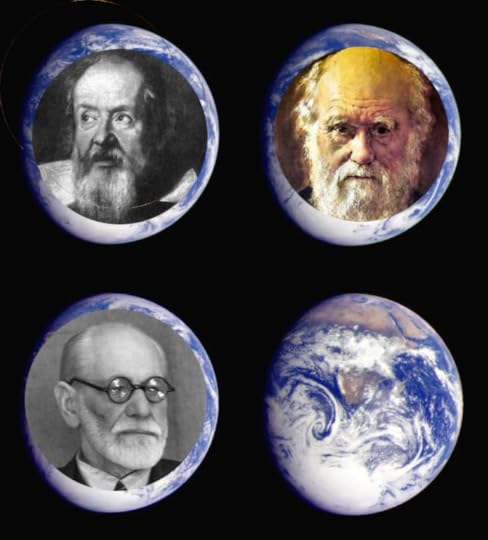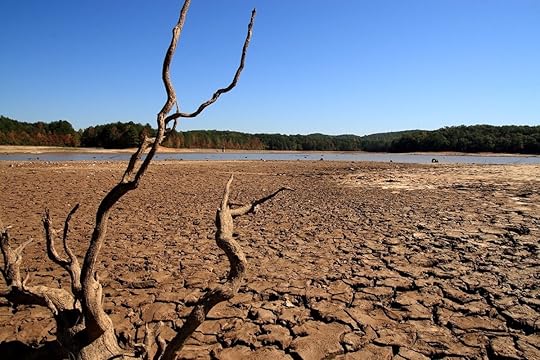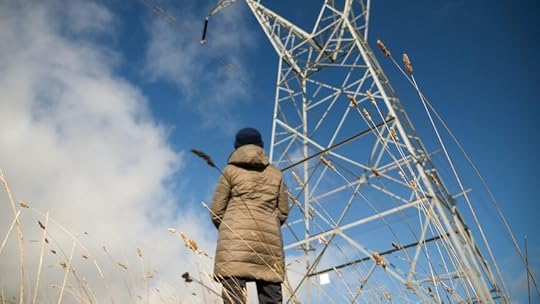Steve Bull's Blog, page 187
September 27, 2022
The Fourth Great Humiliation of Humanity is Upon Us.
If we don’t pull our heads in, we’re doomed. If we do, the future is bright.
 “Galileo Sees the Earth” by sjrankin is licensed under CC BY-NC 2.0._c
“Galileo Sees the Earth” by sjrankin is licensed under CC BY-NC 2.0._cWHEN I WAS TEACHING in Japan 20 years ago, one of my students introduced me to The Three Great Humiliations of Man [sic] in an essay I’d assigned. I was so impressed by her powerful choice of plagiarism, that I passed it with flying colours.
Incidentally, I stopped using the term ‘man’ (and ‘mankind’) 35 years ago. I’m amazed to find people still using it today – alongside some who claim we’re not a biologically sexual species. So much for social cohesion. Forgive the rant.
Just now I searched online for The Three Great Humiliations of Humanity. There were many references to the Century of Humiliation in China, but it turns out Sigmund Freud coined the term. They are: 1/ The discovery by Copernicus and Galileo that we are not the centre of the universe. 2/ Darwin’s discovery that we are descended from apes. 3/ Freud’s discovery that we are not in control of our minds. I don’t think we can accuse Freud of humility!
The Fourth Great Humiliation – or Humbling – of our species is upon us. We’re stuck on this beautiful blue gem in space and we’d better learn to live within it’s limits. If we do, we have a chance at peace, harmony and happiness. We also have a chance to reach a similarly livable planet in the galaxy in the distant future. If we don’t, our prospects are very grim indeed.
…click on the above link to read the rest of the article…
The Power Hungry Podcast: Gail Tverberg
September 26, 2022
A historic global bond-market crash threatens liquidation of the world’s most crowded trades, says BofA
‘If the bond market does not function, then no other market functions, really,’ say Ben Emons of Medley Global Advisors
 A newspaper headline is shown after the Treaty of Versailles was signed in 1919. Global bonds are in one of their worst bear markets since the treaty went into effect in 1920, establishing the terms for peace at the end of World War I.
A newspaper headline is shown after the Treaty of Versailles was signed in 1919. Global bonds are in one of their worst bear markets since the treaty went into effect in 1920, establishing the terms for peace at the end of World War I.SOURCE: UNIVERSITY OF DENVER
Global government-bond markets are stuck in what BofA Securities analysts are calling one of the greatest bear markets ever and this is in turn threatening the ease with which investors will be able to exit from the world’s most-crowded trades, if needed.
Those trades include positions in the dollar, U.S. technology companies and private equity, said BofA strategists Michael Hartnett, Elyas Galou, and Myung-Jee Jung. Bonds are generally regarded as one of the most liquid asset classes available to investors. If liquidity dries up in that market, it’s bad news for just about every other form of investment, other analysts said.
Financial markets have yet to price in the worst-case outcomes for inflation, interest rates, and the economy around the world, despite tumbling global equities along with a selloff of bonds in the U.S. and the U.K. On Friday, the Dow industrials DJIA, -1.62% sank almost 500 points and flirted with a fall into bear-market territory, while the S&P 500 index SPX, -1.72% stopped short of ending the New York session below its June closing low.
U.S. bond yields are at or near multiyear highs. Meanwhile, government-bond yields in the U.K., Germany, and France have risen at the fastest clip since the 1990s, according to BofA Securities.
…click on the above link to read the rest of the article…
The Global Water Crisis Could Crush The Energy Industry
For years, the energy sector, and almost every other sector, has taken water for granted, viewing it as an abundant resource. But as we move into a new era of renewable energy, the vast amounts of water required to power green energy operations may not be so easy to find. And it’s not just renewables that are under threat from water scarcity, as it also hinders fossil fuel production and threatens food security.
In recent months, we have seen extreme droughts across Europe and the U.S., which are finally making people realise the significance of water security. Stefano Venier, CEO of the Italian energy infrastructure company Snam, highlights the huge impact recent droughts have had on both food security and energy production. Labelled as ‘Europe’s worst drought in 500 years’, the low water levels have restricted shipping capabilities, as well as drying up soil and reducing summer crop yields.
Venier explains, “For a long time, water was considered [as being] for free, as something that is fully available in any quantity.” He went on to say, “Now, we are discovering that with climate change … water can become scarce.” And so, “we have to regain the perception of importance, and the value [that] … the water has, also, with respect to … energy production… we have discovered that without water, enough water, we cannot produce the energy we need, or we can’t ship the fuels for filling the power plants,” he added.
…click on the above link to read the rest of the article…
UCSB Scientists See the End of ‘Normal’ Climate
Researcher Asks: ‘What Happens If You Know the Drought Is Never Going to End?’
 Credit: Courtesy
Credit: CourtesyIn August, Governor Gavin Newsom and officials from the Department of Water Resources released a new Water Supply Strategy, saying that because of California’s “hotter, drier climate,” the state needed to find at least 10 percent more water to supply its farms, cities, and industry by 2040.
“We are experiencing extreme, sustained drought conditions in California and across the American West caused by hotter, drier weather,” states the plan. “Our warming climate means that a greater share of the rain and snowfall we receive will be absorbed by dry soils, consumed by thirsty plants, and evaporated into the air.”
The plan says that steadily rising temperatures will overcome even a year or two of better-than-average or average rainfall in Southern California — as in 2018 and 2019 — and will not close what state officials call an “evaporative gap” that threatens California’s water supply.
This new state plan follows the climate science on “aridification.” That’s the scientific term for the “drying trend” that young climate scientist Samantha Stevenson of UCSB’s Bren School of Environmental Science and Engineering identified this year in an extensive global study of the 21st-century hydroclimate.
 Danielle Touma | Credit: Courtesy
Danielle Touma | Credit: CourtesyStevenson said that she wanted to provoke new thinking about what we call drought.
“Drought is already normal in much of the western United States and other parts of the world, such as western Europe,” Stevenson said. “Part of the reason I wrote the paper was to try to say that we need to think about what we mean when we say ‘drought,’ because we’ve been using these definitions based on expectations from 40 years ago. What happens if you know the drought is never going to end?”
…click on the above link to read the rest of the article…
Managing plant surplus carbon to generate soil organic matter in regenerative agriculture
Soil degradation is a global problem. A third of the planet’s land is already severely degraded, and soil is being degraded at a speed that threatens the health of the planet and the civilizations that depend on it (Whitmee et al. 2015). Depletion of soil organic carbon (SOC) resulting from extractive agriculture is a key driver of soil degradation (Lal et al. 2015). Much of this SOC has been released to the atmosphere as carbon dioxide (CO2), a potent greenhouse gas contributing to ongoing climate change, including extreme weather events. Soil degradation also diminishes water infiltration and retention, biodiversity, watershed functions, and the nutritional value of food. Reversing soil degradation is a top global priority (UNCCD 2017).
Yields of major crops have increased substantially in the last century, primarily through intensive chemical fertilization. However, the greater aboveground plant biomass production resulting from chemical fertilization has usually not led to proportional gains in plant inputs to soil and soil organic matter (SOM) accrual (Khan et al. 2007; Man et al. 2021). Instead, these practices, in concert with other intensive agricultural practices such as intensive tillage, monoculture, application of pesticides, and bare fallows, have caused declines in SOM, increases in greenhouse gas emissions, and pollution of waterways (Loisel et al. 2019). However, adopting regenerative agricultural practices, such as substituting chemical with organic fertilizers like compost or manure, reducing tillage, intensifying and diversifying crop rotations, and cover cropping, often increase SOM (McClelland et al. 2021). The mechanisms underlying the positive effects of regenerative agricultural practices on SOM, however, are not well understood. Elucidating these mechanisms would advance our capacity to design agricultural strategies to reliably enhance agroecosystem SOM content, which would assist in reversing soil degradation and enhancing soil quality, food security, and climate change mitigation globally (Amelung et al. 2020).
…click on the above link to read the rest of the article…
IEA Head Warns “Wild West” Energy Scenario Could Unravel Europe
The unity of EU member states could be in jeopardy as a dark winter fast approaches set to trigger a ‘continental scramble’ for energy resources. European countries would be in a “wild west scenario” in their attempt to pursue energy security which would result in souring relations with neighbors and cause worsening fuel and power shortages with risks of social unrest, warned Fatih Birol, the head of the International Energy Agency, who was quoted by the Financial Times.
Birol spoke Thursday in an interview at the inaugural Global Clean Energy Action Forum in Pittsburgh, Pennsylvania, when he explained the energy crisis threatens to shatter EU unity as countries could restrict or stop trading energy resources with neighbors to ensure their own energy security.
“The implications will be very bad for energy, very bad for the economy, but extremely bad politically … if Europe fails this test in energy, it can go beyond energy implications,” Birol said
The head of the Paris-based watchdog energy group was very straightforward about the two possible scenarios:
“EU and members will work in solidarity, supporting each other . . . or there is another scenario, if everybody is for himself.”
Meanwhile, earlier this month, the president of the European Commission, Ursula von der Leyen, was firm in her state of the union address that the unity of EU member states will prevail through this energy crisis.
But there has already been a breakdown in unity among some member states, as FT explains:
Norway’s Nordic neighbours last month blasted Oslo for “selfish” behaviour as it considered pausing electricity exports while it refilled its hydroelectric reservoirs.
…click on the above link to read the rest of the article…
September 25, 2022
Grid renewal generates billion-dollar shock as costs of energy transition become clear
 Consumers are looking at a major increase in spending on power networks across Australia.(ABC News: Hugh Hogan)
Consumers are looking at a major increase in spending on power networks across Australia.(ABC News: Hugh Hogan)Australian consumers have been told to brace for big hikes in their power bills after a watchdog revealed the true costs of overhauling the grid to deal with the renewable energy transition.
Key points:
Experts say tens of billions of dollars in extra spending will be needed on poles and wiresAn economic watchdog has ruled in support of $1 billion in extra spending by WA’s network utilityAcross Australia, network providers are tipped to seek big increases in funding to handle the renewable energy surgeIn a decision heralded as a landmark, Western Australia’s economic regulator this month said the state’s major electricity network provider should be allowed to spend $9 billion over the next five years – $1 billion more than it requested.Network— or poles and wires — costs typically account for up to half the average electricity bill, with the rest made up of costs associated with generation, retailing and environmental policies.
Economic Regulation Authority chairman Steve Edwell said the draft decision reflected the urgent need for upgrades to Western Power’s network to ensure it could handle the surge of renewable energy flooding onto the system.
But Mr Edwell, who was also the inaugural chairman of the Australian Energy Regulator, said it was also a sign of what was to come around the country, where poles-and-wires companies face a race against time and a huge increase in costs to make sure they can keep up with the energy transition.
“The period between now and 2027 is pivotal,” Mr Edwell said.
“We’ve got to get it right and we’ve got to make sure the grid is in as good a shape as it can be to enable this transformation to continue at pace.
…click on the above link to read the rest of the article…
September 24, 2022
“Ferocious Fiona” Makes Landfall In Canada, Leaving Hundreds Of Thousands Without Power
Powerful storm Fiona battered eastern Canada on Saturday with hurricane-force winds and torrential rains, leaving hundreds of thousands of people without power.
The National Hurricane Center said Post-Tropical Cyclone Fiona made landfall early Saturday morning on the northeast corner of mainland Nova Scotia. It added Fiona had maximum sustained winds of 81 mph, peaking at times of over 100 mph.
Canadian Hurricane Center said Fiona was one of the lowest pressured land falling storms ever to hit Canada. For some context, lower the pressure means stronger the storm.
As of 0800 ET, the storm was 160 miles northeast of Halifax, packing winds of 85 mph and barreling north at around 23 mph.
According to Nova Scotia Power, over 400,000 people across the province of about one million were without power as of 0800 ET.
… and there goes the internet.
Social media users tweeted footage of the damage left behind by Fiona.
…click on the above link to read the rest of the article…
Poland Begins Handing Out Iodine Pills On Fears Of Ukraine Nuclear Plant Meltdown
Poland has begun a program of distributing iodine tablets to emergency workers and first responders, starting with regional fire departments – who can in turn hand them out to the general population – in the event of a possible radioactive disaster at Europe’s largest nuclear power plant.
A Polish deputy minister first announced the plan on Thursday, warning of the possibility of dangerous radioactive exposure amid continued fighting in neighboring Ukraine, where technicians at the Zaporizhzhia Nuclear Power Plant continue to struggle to maintain safeguards.
“After the media reports about battles near the Zaporizhzhia Nuclear Power Plant, we decided… ahead of time to take protective action to distribute iodine,” the Polish official, Blazej Pobozy, said in a national radio broadcast.
“I would like to reassure all citizens that these are routine, preemptive actions that are to protect us in the event of a situation which… I hope will not happen.” Iodine tablets can help protect against conditions associated with radioactive exposure such as thyroid cancer.
The plant has suffered frequently cut power cables, having been removed from the nation’s power grid multiple times and reverting to back-up measures, amid shelling in the area as some 500 Russian troops have occupied the complex since March.
Both sides have continued to blame the other for the deteriorating operating conditions, which earlier in the month caused plant operators to take a sixth reactor off the grid out of an abundance of caution while a power line was being restored after fire.
Earlier this month, Ukrainian President Volodymyr Zelenskiy said, “Due to Russian provocation, the Zaporizhzhya plant is one step away from a radiation disaster.”
…click on the above link to read the rest of the article…






